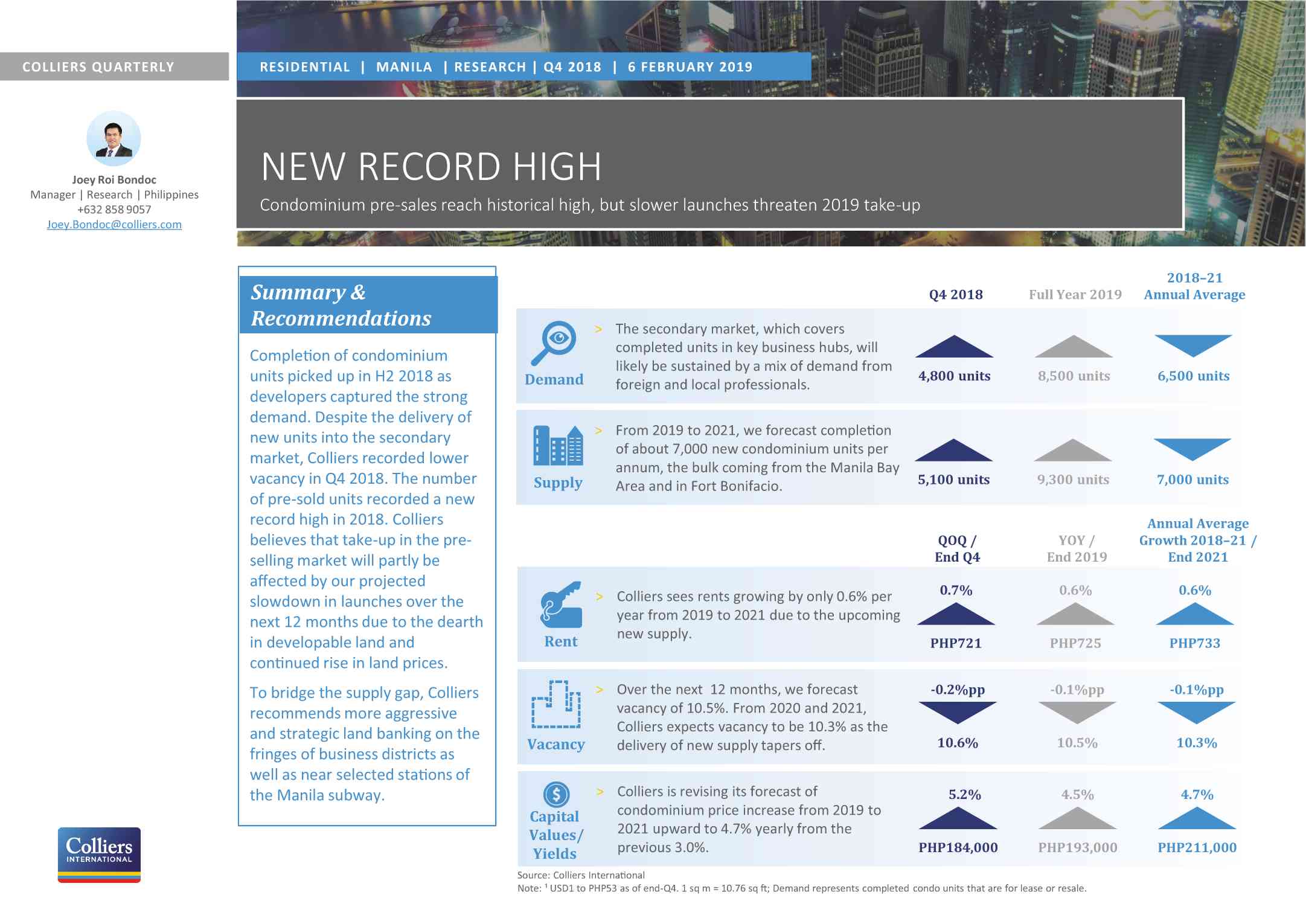Residential condo take-up remains strong
High inflation and rising interest rates did little to dampen the take-up of residential condominium units in Metro Manila, which hit a historical high of 54,000 last year.
In a report on Wednesday, Colliers International Philippines said the strong take-up last year comprised mostly of affordable to mid-income units with prices ranging from P1.7 million to P5.9 million. And such a healthy performance is expected to be carried over this year, despite “slower launches.”
“Colliers believes that pre-sales in 2019 will likely remain strong given the strong end-user demand,” Colliers said.
“However, topping the 2018 sales figures might be a challenge given Collier’s projected slowdown in launches due to the dearth of available developable land in Metro Manila and the continued acceleration of land prices in the country’s key business districts. We also see slower launches having a spill over effect on take-up figures in 2020 and 2021,” it added.
Completions
In terms of supply, Colliers said some 11,800 residential condo units were completed last year. This brought Metro Manila’s condo stock to 118,900 units as of end December 2018.
For 2019, Colliers projects the completion of about 9,300 new condo units, 74 percent of which are expected to come from Fort Bonifacio and Manila Bay Area, which in particular, continues to enjoy “brisk demand from Chinese offshore gaming firms as well as a mix of foreign and local investors.”
“By the end of 2021, Fort Bonifacio will likely retain its position as the largest residential condominium market in Metro Manila with close to 40,000 units. We see Manila Bay Area overtaking the Makati central business district as the second largest market as Colliers projects stock of 28,800 units versus Makati’s 28,700 units,” Colliers explained.
Given the upcoming supply, Colliers expects rents to grow by only 0.6 percent a year from 2019 to 2021, while vacancy over the next 12 months is forecasted to hit 10.5 percent. Capital values meanwhile are seen to increase by a higher 4.7 percent a year from 2019 to 2021 from the previous 3 percent.
Supply gap
Despite these completions, Colliers expects a supply gap, for which it stressed the need for property developers to pursue a more aggressive and strategic landbanking.
More specifically, Colliers is urging property developers to explore residential potential in Quezon City, Ortigas Center, Manila Bay Area and the so-called fringe areas. Real estate firms should likewise maximize the potential opportunities arising from the government’s “Build, Build, Build” initiative.
For instance, Colliers pointed out that the Manila subway, reportedly the most expensive project approved by the government, will have the first three stations in Quezon City—Mindanao Avenue, Tandang Sora and North Avenue.
Colliers thus sees “Quezon City benefiting from the planned infrastructure as seven of the 13 metro stations are in Quezon City, along with improving connectivity given the construction of the Metro Rail Transit-7 (MRT-7) and the common LRT-MRT station.”
Among the areas in Quezon City that would have the residential potential include those near the North Avenue, Quirino and Tandang Sora stations.
“In our opinion, the development of new residential towers in Ortigas is also feasible as new condominium units are likely to complement the new office space to be developed in the business hub from 2019 to 2021. Hence, we encourage developers with parcels of land in Quezon City and Ortigas to explore the development of residential projects in these areas,” Colliers explained.
Colliers further opined that due to the lack of developable land in major business districts such as Makati CBD and Fort Bonifacio, developers should look to fringe areas as sites for future residential developments. These areas include Manila, Caloocan-Malabon-Navotas (Camanava), Ortigas fringes, Makati fringes and Pasay-Parañaque areas.
“In our opinion, residential projects in these areas continue to serve the end-user demand of mid-income households that are upgrading to condominium living. Other projects in northern Quezon City should attract households from as far as Bulacan, especially with the scheduled completion of the Metro Rail Transit (MRT) 7 in 2021. Those projects in Southern Metro Manila should entice families from Southern Luzon provinces of Cavite and Laguna,” Colliers futher noted.

